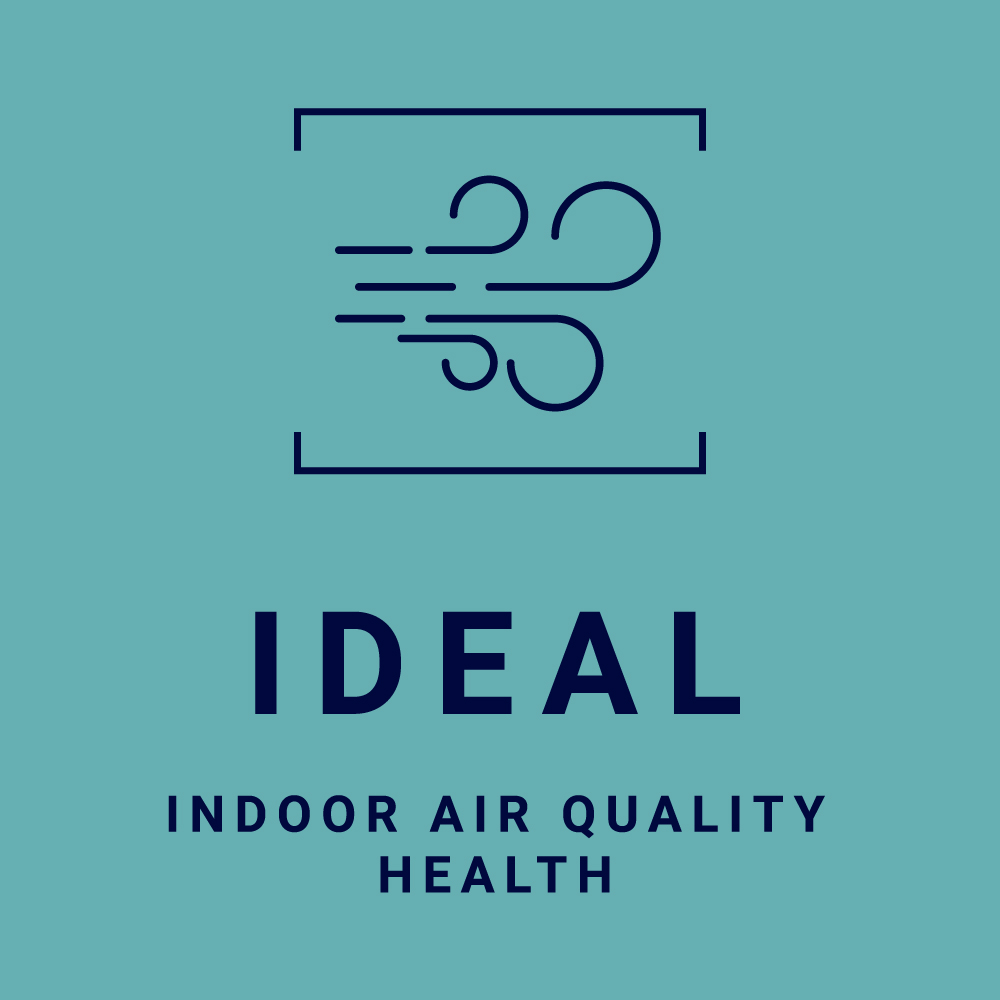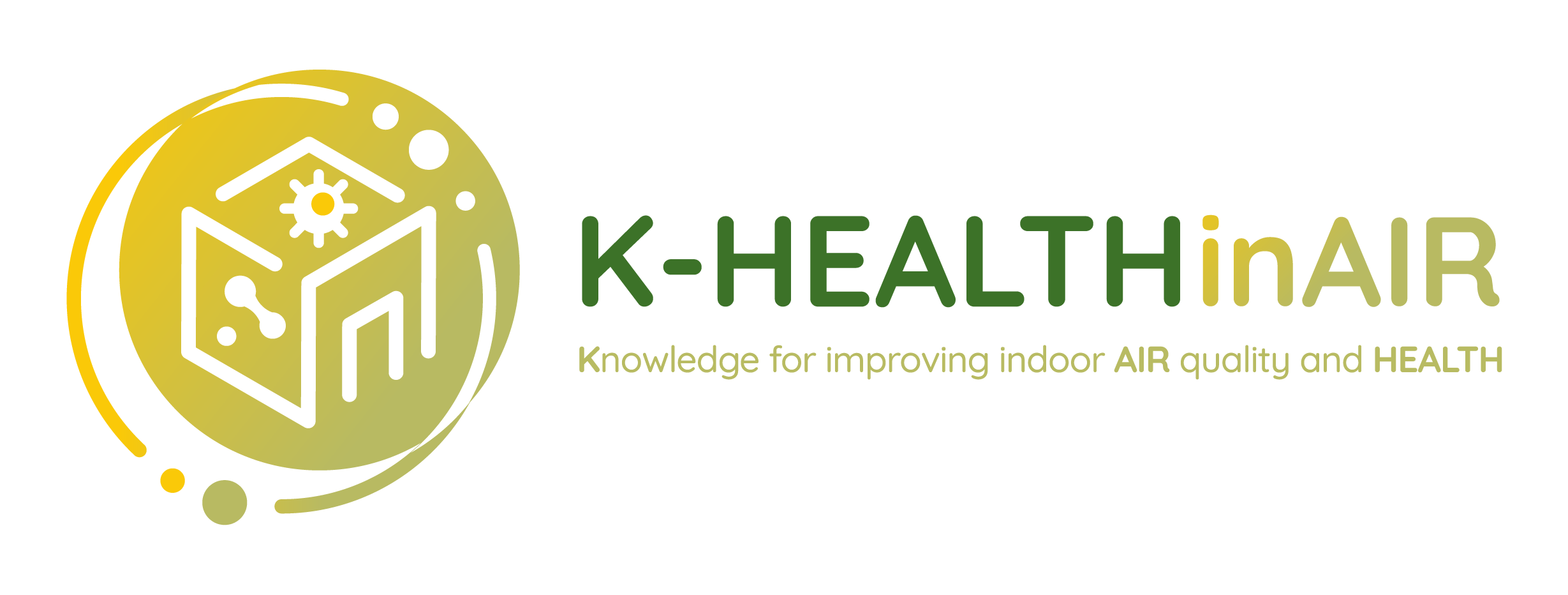SCIENTIFIC PUBLICATIONS
K-HEALTHinAIR SCIENTIFIC PUBLICATIONS
Protocol for the enhanced management of multimorbid patients with COPD and severe asthma: role of indoor air quality
This study implements a novel integrated care model combining continuous IAQ monitoring, advanced lung function assessment using oscillometry, digital adaptive case management, and predictive modelling for early detection and management of exacerbations. These interventions are designed to identify environmental and clinical triggers of acute events, optimise personalized care, and reduce unplanned hospitalisations in high risk patients.
Verification and Usability of Indoor Air Quality Monitoring Tools in the Framework of Health-Related Studies
Indoor air quality (IAQ) significantly impacts human health, particularly in enclosed spaces where people spend most of their time. This study evaluates the performance of low-cost IAQ sensors, focusing on their ability to measure carbon dioxide (CO2) and particulate matter (PM) under real-world conditions.
Sources, levels, and determinants of indoor air pollutants in Europe: A systematic review
The aim of this study was to systematically review the available evidence regarding the sources, determinants and concentrations of indoor air pollutants in a set of scenarios under study in K-HEALTHinAIR project. To this end, a systematic review was performed to review the available studies published between the years 2013–2023, for several settings (schools, homes, hospitals, lecture halls, retirement homes, public transports and canteens), conducted in Europe, where sources and determinants of the indoor pollutants concentrations was assessed.
SynAir-G
Disrupting Noxious Synergies of Indoor Air Pollutants and their Impact on Childhood Health and Wellbeing
SynAir-G SCIENTIFIC PUBLICATIONS
Addressing adverse synergies between chemical and biological pollutants at schools-The 'SynAir-G' hypothesis
While the number and types of indoor air pollutants is rising, much is suspected but little is known about the impact of their potentially synergistic interactions, upon human health. Gases, particulate matter, organic compounds but also allergens and viruses, fall within the ‘pollutant’ definition. Distinct populations, such as children and allergy and asthma sufferers are highly susceptible, while a low socioeconomic background is a further susceptibility factor; however, no specific guidance is available. We spend most of our time indoors; for children, the school environment is of paramount importance and potentially amenable to intervention. The interactions between some pollutant classes have been studied. However, a lot is missing with respect to understanding interactions between specific pollutants of different classes in terms of concentrations, timing and sequence, to improve targeting and upgrade standards. SynAir-G is a European Commission-funded project aiming to reveal and quantify synergistic interactions between different pollutants affecting health, from mechanisms to real life, focusing on the school setting. It will develop a comprehensive and responsive multipollutant monitoring system, advance environmentally friendly interventions, and disseminate the generated knowledge to relevant stakeholders in accessible and actionable formats. The aim of this article it to put forward the SynAir-G hypothesis, and describe its background and objectives.
Monitoring of Indoor Air Quality in a Classroom Combining a Low-Cost Sensor System and Machine Learning
Monitoring indoor air quality in schools is essential, particularly as children are highly vulnerable to air pollution. This study evaluates the performance of the low-cost sensor-based air quality monitoring system ENSENSIA, during a 3-week campaign in an elementary school classroom in Athens, Greece. The system measured PM2.5, CO, NO, NO2, O3, and CO2. High-end instrumentation provided the reference concentrations. The aim was to assess the sensors’ performance in estimating the average day-to-day exposure, capturing temporal variations and the degree of agreement among different sensor units, with particular attention to the impact of machine learning (ML) calibration. Using the factory calibration settings, the CO2 and PM2.5 sensors showed strong inter-unit consistency for hourly averaged values. The other sensors, however, exhibited inter-unit variability, with differences in the reported average day-to-day concentrations ranging from 20% to 160%. ML-based calibration was investigated for the CO, NO, NO2, and O3 sensors using measurements by reference instruments for training and evaluation. Among the eleven ML algorithms tested, the Support Vector Regression performed better for the calibration of the CO, NO2, and O3 sensors. The NO sensor was better calibrated using the Elastic Net algorithm. The inter-unit variability was reduced by a factor of two after the ML calibration. The daily average error compared to the reference measured was also reduced by approximately 15–50% depending upon the sensor.
Analyzing Pathophysiology and Immune Cells and Their Cytokines and Mediators in Precision-Cut Slices of the Murine Lung
Understanding the dynamic pathophysiology of diseases in the lung, such as asthma and chronic asthma, chronic obstructive pulmonary disease, and lung cancer, is crucial for the treatment, analysis, and outcome of these diseases. Unlike other traditional models, we suggest a protocol that is sustainable and reproducible and offers different analysis methods while maintaining in vivo lung architecture and immune dynamics. This protocol allows one to study the pathophysiological changes, including changes to the immune cells, cytokines, and mediators, in 30 precision-cut lung slices from a single murine lung. To accomplish this, the murine lung is infused with 2.5% low-melting-point agarose and is precision-cut-sliced. Our method also supports cell culture in refined medium and stimulation with clinically relevant stimuli, which helps to clarify the mechanisms of the disease. Evaluation of the samples and their supernatant includes multiplex assays, ELISA, histology, and immunohistochemistry. Additional sections are used to extract RNA for quantitative real-time PCR and RNA sequencing and/or other selected analysis, like flow cytometry. Using this method, we obtained murine lung slices that preserve the pathophysiology of the disease and allow a comprehensive analysis unlike other already-existing protocols. By retaining the dynamic immune mechanisms, we are able to see the histological damage caused by each disease. The results of this protocol can be used to improve our understanding and therapy options. © 2025 The Author(s). Current Protocols published by Wiley Periodicals LLC. Basic Protocol: Obtaining precision-cut lung slices (PCLSs) from the murine lung Support Protocol 1: LL/2 cell treatment with G-418 solution Support Protocol 2: Murine model of lung adenocarcinoma and in vivo imaging Support Protocol 3: H&E staining of PCLS sections Support Protocol 4: Measuring cytokines by ELISA Support Protocol 5: Measuring cytotoxic activity in PCLS conditioned medium Support Protocol 6: Analysis of RNA from PCLSs by real-time PCR Support Protocol 7: Flow cytometry analysis of cells isolated from PCLSs.
LEARN SCIENTIFIC PUBLICATIONS
Differential impact of diesel exhaust particles on glutamatergic and dopaminergic neurons in Caenorhabditis elegans: A neurodegenerative perspective
This study examined the neurodegenerative effects of diesel exhaust particles (DEP) in Caenorhabditis elegans. Exposure to DEP (0.167 and 1.67 µg/cm²) led to developmental delays, altered locomotion, and changes in antioxidant gene expression (sod-3, gst-4). Significant reductions in movement speed and swimming activity were observed, especially at higher doses. Glutamatergic neurons showed clear degeneration, while dopaminergic neurons exhibited structural deformities without major degeneration. In silico docking suggested DEP acts as a competitive inhibitor, more strongly affecting glutamatergic transporters than dopaminergic receptors. The findings link locomotion defects to glutamatergic neurodegeneration and highlight environmental health risks from DEP exposure.
Optical anapoles excited by UV-A illumination
This study demonstrates the excitation of optical anapole states in the ultraviolet (UV) range (350–380 nm) using TiO₂ nano-rectangles with different length-to-width ratios. Simulations confirm these modes, and a periodic 2D arrangement on fused silica is proposed. Understanding UV anapole states is key to developing advanced photonic devices and enhancing nonlinear effects like third-harmonic generation for vacuum UV light.
Particulate matter-induced oxidative stress – Mechanistic insights and antioxidant approaches reported in in vitro studies
This study demonstrates the excitation of optical anapole states in the ultraviolet (UV) range (350–380 nm) using TiO₂ nano-rectangles with different length-to-width ratios. Simulations confirm these modes, and a periodic 2D arrangement on fused silica is proposed. Understanding UV anapole states is key to developing advanced photonic devices and enhancing nonlinear effects like third-harmonic generation for vacuum UV light.
Microfluidic-based skin-on-chip systems for safety assessment of nanomaterials
The skin, constantly exposed to natural and synthetic nanomaterials, faces risks ranging from corrosion to cancer. Skin-on-chip systems offer a promising tool for assessing nanomaterial safety by closely mimicking skin physiology. This review discusses recent advances in these models, strategies to simulate skin functions, and improved control over nanomaterial exposure and cellular transport. It also outlines future opportunities and challenges in design, fabrication, and regulatory acceptance.
EDIAQI SCIENTIFIC PUBLICATIONS
Evidence driven indoor air quality improvement: An innovative and interdisciplinary approach to improving indoor air quality
Indoor air pollution is a recognized emerging threat, claiming millions of lives annually. People are constantly exposed to ambient and indoor air pollution. The latest research shows that people in developed countries spend up to 90% of their time indoors and almost 70% at home. Although impaired Indoor Air Quality (IAQ) represents a significant health risk, it affects people differently, and specific populations are more vulnerable: children, the elderly, and people with respiratory illnesses are more sensitive to these environmental risks. Despite rather extensive research on IAQ, most of the current understanding about the subject, which includes pollution sources, indoor–outdoor relationships, and ventilation/filtration, is still quite limited, mainly because air quality monitoring in the EU is primarily focused on ambient air quality and regulatory requirements are lacking for indoor environments. Therefore, the EDIAQI project aims to improve guidelines and awareness for advancing the IAQ in Europe and beyond by allowing user-friendly access to information about indoor air pollution exposures, sources, and related risk factors.
Associations between indoor fungal community structures and environmental factors: Insights from the Evidence-Driven Indoor Air-Quality Improvement study',
Indoor fungal communities, found in household dust, significantly influence indoor air quality and health. These communities are shaped by environmental, socioeconomic, and household factors. However, studies on indoor mycobiomes, particularly in Croatia, remain limited. This study investigates the relationship between environmental and household factors and indoor fungal communities, focusing on their diversity, composition, and potential health impacts in Croatian households. Dust samples from 66 Croatian households were analyzed using fungal ITS sequencing. Statistical analyses, including alpha diversity measures, were conducted to evaluate the influence of variables such as pet ownership, number of siblings, and cleaning habits on fungal diversity and abundance. Dominant genera included Malassezia, Cladosporium, and the family Didymosphaeriaceae. Pet ownership and sibling presence were linked to higher fungal diversity, with outdoor-associated genera such as Aureobasidium being more abundant in these households. Cleaning practices selectively altered fungal communities, with frequent cleaning reducing diversity, but not eliminating resilient taxa like Malassezia. This study highlights the interplay between environmental, household, and socioeconomic factors in shaping indoor fungal communities. The findings underscore the importance of addressing indoor fungal diversity to improve air quality and health, particularly in households with vulnerable populations.
Volatile organic compounds (VOCs) and polycyclic aromatic hydrocarbons (PAHs) in indoor environments: A review and analysis of measured concentrations in Europe
Indoor air quality is a significant aspect of public health, yet it remains less studied than outdoor air pollution. Understudied indoor pollutants include volatile organic compounds (VOCs) and polycyclic aromatic hydrocarbons (PAHs). This review focuses on these two groups of compounds known for their health effects, including respiratory issues, neurological disorders, and carcinogenicity. We systematically compiled and analyzed data from studies reporting measured concentrations of VOCs and PAHs in European indoor environments—homes, schools, and offices—published in the past two decades. Concentration levels vary substantially across studies, influenced by regional differences, climate, building type, ventilation systems, and indoor activities. Identified sources include tobacco smoke, cooking, heating (e.g., biomass burning), and off-gassing from construction and furnishing materials. Our analysis reveals clear geographic patterns: lower concentrations of VOCs and PAHs are consistently reported in Northern and Western European countries, likely due to stricter air quality regulations, cleaner outdoor air, greater use of electric heating, and more advanced ventilation systems. Conversely, higher concentrations are more commonly observed in Southern and Eastern Europe, where biomass heating and poorer ventilation remain more prevalent. Seasonal variation also has a significant role, with higher indoor levels typically measured during colder months due to increased heating and reduced air exchange. This highlights the need for improved indoor air quality management practices and regulatory standards to minimize the health risks associated with VOCs and PAHs. This review of 46 scientific publications is aimed at informing future studies and guiding future field measurements and risk assessments in epidemiological studies.
Linking the bed dust microbiome with environmental factors and child respiratory health
Humans spend up to 90% of their time indoors and are exposed to a significant number of microbes in their homes, which can have important implications for their health.
This study focused on analysing the influence of environmental factors on microbiome diversity and abundance in bed dust and linking the exposure to dust bacteria with asthma.
A total of 90 dust samples were collected from homes of asthmatic patients (n = 59) and controls (n = 31) aged 5–18 years. The bacterial fraction of the microbiome was analysed
using 16S rRNA gene high-throughput sequencing on the Illumina MiSeq platform and downstream analyses in QIIME2 and R. Microbiome profiles were associated with asthma and relevant environmental and household data.
Higher bacterial β-diversity in the environment was shown to be inversely associated with asthma (p = 0.009). Also, living environment (p = 0.002), housing type (p = 0.004), presence of pets in the household (p = 0.001), and cleaning practices (p = 0.006 for dusting and p = 0.011 for vacuuming) were
prominent environmental factors affecting the bed dust microbiome. Our results suggest significant differences in bacterial community composition between
individuals with and without asthma and the interaction between indoor microbiome and asthma is
mediated by environmental factors in the household.
InChildHealth
Identifying determinants for indoor air quality and their health impact in environments for children: measures to improve indoor air quality and reduce disease burdens
InChildHealth SCIENTIFIC PUBLICATIONS
Filling the knowledge gap: Scoping review regarding sampling methods, assays, and further requirements to assess airborne viruses
This scoping review examines methods for assessing airborne virus exposure in occupational and indoor settings. Analyzing 50 studies from 2010 to 2023, it highlights the importance of early detection to prevent virus spread and evaluate protective measures. Key findings include inconsistencies in sampling methods, reporting gaps, and lack of contextual data, which hinder result comparison and consensus. The study identifies research gaps and calls for standardized approaches tailored to specific assessment goals.
Cleaning products: Their chemistry, effects on indoor air quality, and implications for human health
The use of cleaning and disinfecting products rose during the COVID-19 pandemic, increasing indoor exposure to harmful chemicals and particulate matter. This review analyzes their impact on air quality and health, highlighting links to asthma, rhinitis, and respiratory issues, especially in children and professional cleaners. Reducing exposure requires safer product formulations, better ventilation, informed product choices, and clearer labeling. The study also outlines best practices and calls for further research.
The Representativeness of Outdoor Particulate Matter Concentrations for Estimating Personal Dose and Health Risk Assessment of School Children in Lisbon
This study assessed whether outdoor particulate matter (PM) data from a fixed station could estimate personal PM exposure in schoolchildren. Simulations compared outdoor-only and actual exposure scenarios. Personal PM₁₀ and PM₂.₅ doses were 23.4% and 20.2% higher than ambient estimates, respectively. Including hygroscopic growth increased ambient doses further. Regression analyses showed poor correlation between ambient and personal doses, especially for PM₁₀, indicating that ambient data alone are unreliable for estimating children’s real exposure, particularly for PM₁₀.
Modelling approaches to particle deposition and clearance in the human respiratory tract
This study reviews dosimetry and clearance models used to estimate particle deposition in the human respiratory tract and assess internal exposure. It examines how factors like particle properties, respiratory geometry, and breathing conditions influence deposition. Modeling approaches include empirical methods, 1D flow models, and CFD simulations, with emphasis on accurately representing hygroscopicity. The integration of dosimetry with physiologically based pharmacokinetic (PBPK) models is proposed to better predict particle-bound chemical transport and health effects across organs.
Inquire
Identification of chemical and biological determinants, their sources, and strategies to promote healthier homes in Europe
Inquire SCIENTIFIC PUBLICATIONS
Coming soon...
TWINAIR SCIENTIFIC PUBLICATIONS
Investigating the Sensitivity of Low-Cost Sensors in Measuring Particle Number Concentrations across Diverse Atmospheric Conditions in Greece and Spain
Low-cost sensors (LCSs) for particulate matter (PM) concentrations have attracted the interest of researchers, supplementing their efforts to quantify PM in higher spatiotemporal resolution. The precision of PM mass concentration measurements from PMS 5003 sensors has been widely documented, though limited information is available regarding their size selectivity and number concentration measurement accuracy. In this work, PMS 5003 sensors, along with a Federal Referral Methods (FRM) sampler (Grimm spectrometer), were deployed across three sites with different atmospheric profiles, an urban (Germanou) and a background (UPat) site in Patras (Greece), and a semi-arid site in Almería (Spain, PSA). The LCSs particle number concentration measurements were investigated for different size bins. Findings for particles with diameter between 0.3 and 10 μm suggest that particle size significantly affected the LCSs’ response. The LCSs could accurately detect number concentrations for particles smaller than 1 μm in the urban (R² = 0.9) and background sites (R² = 0.92), while a modest correlation was found with the reference instrument in the semi-arid area (R² = 0.69). However, their performance was rather poor (R² < 0.31) for coarser aerosol fractions at all sites. Moreover, during periods when coarse particles were dominant, i.e., dust events, PMS 5003 sensors were unable to report accurate number distributions (R² values < 0.47) and systematically underestimated particle number concentrations. The results indicate that several questions arise concerning the sensors’ capabilities to estimate PM2.5 and PM10 concentrations, since their size distribution did not agree with the reference instruments.
A text analytic framework for gaining insights on the integration of digital twins and machine learning for optimizing indoor building environmental performance
Recent technological advancements in distributed sensing, pervasive computing, context-awareness, machine learning and Digital Twins (DTs) allow the built environment to cope with upcoming challenges in a better way than before and achieve comfort and well-being in buildings. This paper takes a unique approach by not conducting a systematic and exhaustive review, that would require enormous effort to uncover intricate interdependencies among various subtopics. Instead, it proposes a framework leveraging Artificial Intelligence and Machine Learning (AI/ML) techniques to extract valuable insights from the existing literature. Adopting the Digital Twin high-level architecture as its foundation, the paper introduces a clustering approach to scrutinize Indoor Environmental Quality, Energy Efficiency, and Occupant Comfort—key facets influencing indoor building performance. This innovative methodology aims to provide a more nuanced understanding of the relationships within these critical aspects by harnessing the capabilities of AI/ML techniques and the conceptual framework of Digital Twin architecture.







